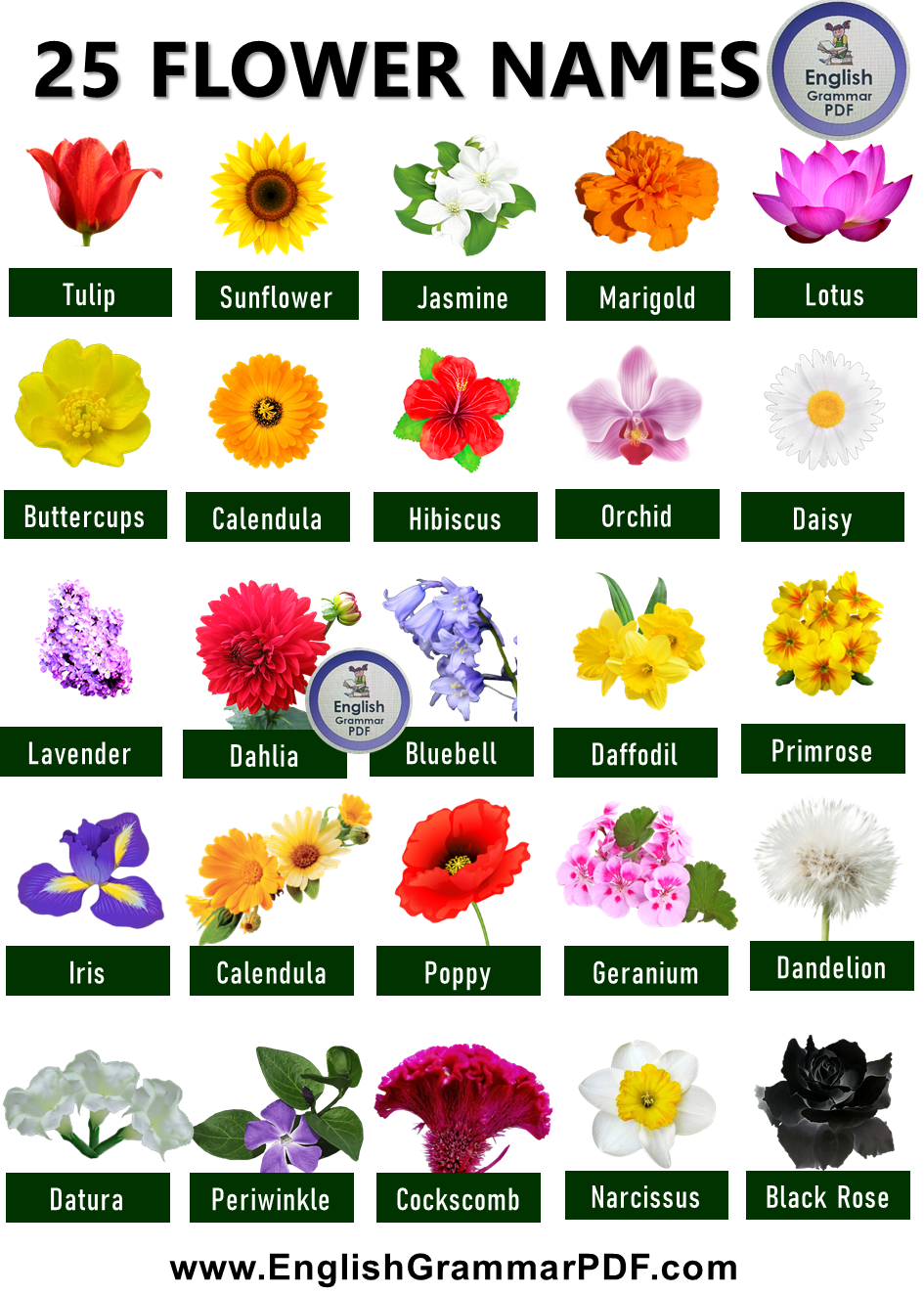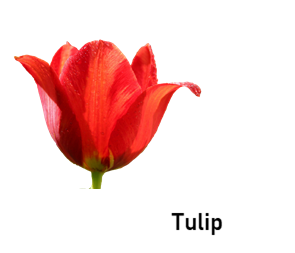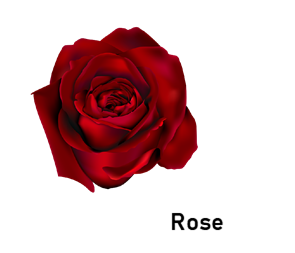25 Flowers Name List in English

Flower are very beautiful and in this lesson we are going to discuss names of 25 common flower with picture of each. This list of flower names is very useful, because this list has some very common flowers that we usually see around. Flower are the beauty of this world and that why learning our flowers is very interesting. Flower names with images will help you to memorize the English names of the 25 flower and later whenever you see a flower there names will pop up in your mind.
List of 25 Flower Names
- Daisy
- Dahlia
- Daffodil
- Chrysanthemum
- Cherry Blossom
- Calendula
- Bluebell
- Water Lily
- Tulip
- Sunflower
- Snowdrop
- Rose
- Poppy
- Orchid
- Marigold
- Lotus
- Lily
- Lavender
- Jasmine
- Iris
- Hibiscus
- Geranium
- Epimedium
- English Daisy
- Orchid
Here are the definitions of Flowers:
Daisy
 Daisy’s name is derived from the Old English word for the day, which is “dæg”. In Old Norse daisa means “to increase” and in German, it translates to “day” as well. Daisy was first recorded as a given name in 1534 CE. It began gaining popularity after George Gascoigne named his poem “Floures for Latine Spekking” “Daisy”.
Daisy’s name is derived from the Old English word for the day, which is “dæg”. In Old Norse daisa means “to increase” and in German, it translates to “day” as well. Daisy was first recorded as a given name in 1534 CE. It began gaining popularity after George Gascoigne named his poem “Floures for Latine Spekking” “Daisy”.
Dahlia

The origin of the name Dahlia comes from a nordic botanist named Anders Dahl. In the plant’s native Mexico it was first discovered in the early 1700s by Europeans. It was named “dahlia” after Dahl who first brought samples back to Europe.
Daffodil

The origin of the name Daffodil dates back to the 14th Century. It comes from the combination of “asphodel” and the Greek word for yellow, “leukon”. Daffodils are known to be a symbol of rebirth and regeneration because they usually bloom around early spring and die in the summer.
Chrysanthemum

The name Chrysanthemum is derived from the Greek words “chrysos” and “anthemon”. The Greeks believed that these flowers grew where the golden petals of the sunset fell. The flower was named in English in the 13th century from a word that means “golden flower”.
Calendula

The Latin name of Calendula comes from the Roman Goddess of flowers, “Calendae”, and the word for marigold, “Calendula”. The English name comes from the same word.
Calla lily

The Calla lily has its origins in South Africa, in the plant Arum Italicum. The name comes from the Greek word “kallos” meaning beautiful and referring to the shape of the petals.
Cherry Blossom

Cherry Blossom is a common name for the flowering cherry tree. There are over 1000 types of this flower, but most have pink petals.
Bluebell

The name Bluebell in English was recorded in the 14th century. It came from an old European word “belle” that meant “bright” and the plant’s bell-shaped flower.
Water Lily

The Water Lily has its origins in the Americas and came to Europe by way of French explorers. It was previously known as “lily pad” and “water lily” in English.
Iris

The Iris flower is named after the Greek goddess of the rainbow, “iris”. It was recorded in English writing in the 14th century, but has its origins in Greek mythology.
Tulip

The name Tulip comes from “tulband”, which means turban in Turkish. The Turks thought that the flower’s shape made it look like a wrapped turban.
Sunflower

Sunflowers got their name in English in the 16th century when botanists compared the flower’s face to the sun. The sunflower was first recorded by the French in 1562.
Crocus

Crocus is derived from the Greek word “krokos”, which means saffron. The flower blossoms into bright purple, yellow, or white flowers that resemble the color of this spice.
Rose

The name rose in English comes from the old German word “roz” and an old French word “ros”. Both of these words mean “dew” in their respective languages. The Latin name for the flower, “rosa”, also means dew.
Lilac

The name Lilac is derived from the Latin word “lilac”, which came from Persian words “lila” and “kan”. Both of these words mean “flower”.
Morning Glory

The flower was first called the morning glory because it typically starts to open around 7:00 am. It was recorded in English writing in the 16th century and has origins in Spanish and Mesoamerican cultures.
Poppy

The name Poppy in English was recorded in the 13th century and comes from the old English word “popigay”, which means “seed”.
Orchid
The name Orchid derives from the Greek word for testicle, “orchis”. This is because of their shape, but they are not related to male reproductive organs.
Petunia
The petunia was named after the Austrian botanist, Petrus Jacobus Matthaeus, who discovered it in 1839. The flower has its origins in South America.
Peony
The name Peony comes from the Greek word “paein” meaning “to heal”. This flower is used in China and Japan to make medicine.
Tulip
The Tulip got its name in English in the 15th century when it was brought from Turkey to Europe. It has origins in ancient Persia.
Iris
The Iris flower is named after the Greek goddess of the rainbow, “iris”. It was recorded in English writing in the 14th century, but has its origins in Greek mythology.
Marigold
The name Marigold comes from the Greek word “margaron”, which means “gold”. The flower has its origins in Greece, Africa, and Asia.
Download PDF of Names of Flower


